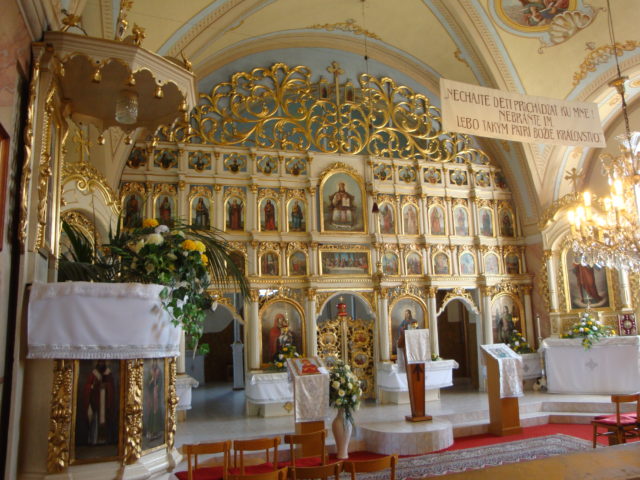Because I am not particularly interesting, I avoid blogging about myself these days. I save all of my autobiographical reflections (a.k.a. things I overhear in West Michigan Christian coffee shops) for Twitter. As most of my blog readers know by now, I am Greco-Catholic and have spent the bulk of my religious life, from childhood to my late 37th year, in and around Eastern Christianity. The biggest “break” I took from this reality was roughly between 2011-13 when I found myself attending the traditional Latin Mass on a regular basis. My tiny parish, St. Michael Ukrainian Catholic Church, in Grand Rapids, MI has undergone serious trials in the last couple of years, not the least of which being the loss of its pastor due to serious health complications. With only visiting priests available, typically on Saturday evenings, it has been a challenge to get my family there and to keep them focused when all they want to do is wind down for the night. That’s on me. What is also on me is a lack of serious participation in the life of my parish and really local Catholic life as a whole. To say that life is “contradictory” and “confused” would be a bit of an understatement, though perhaps it is like that all over. With few exceptions, West Michigan Catholicism, when it is ostensibly “conservative” or even “traditional,” is largely reflective of peculiarly American religiosity. Think of John Paul II/Benedict XVI-style theological sensibilities blended with neoliberal economics, Calvinist iconoclasm, and a frightening dose of “Prosperity Gospel” thinking. Liberal West Michigan Catholicism, as far as I can tell, looks like liberal Catholicism plain and simple; there’s nothing terrifyingly special about it.
As I have written about before, the experience of being Greek Catholic, especially in my younger years, has never been easy. Not “Catholic enough” for Latins and “traitors” to the Orthodox, there’s an ever-present temptation to pick a side and cease being altogether. American Orthodoxy may be splintered and insular, but if feels like a more sensible home from time to time. The Roman Catholic Church, by virtue of its size, is a wonderful place to hide out; there’s no beating it for the ease in which one can find a parish, a Mass, a quiet “way of life” and be perfectly anonymous. The great exception to that route is traditional Latin Catholicism which, despite its expansion over the last decade, remains on the peripheries of the Church in most parts of the world (and most dioceses in the United States). It’s unfortunate, then, that traditional Latin Catholics typically don’t get along with their Eastern brethren for a variety of chauvinistic reasons. There is a part of me that really believes both sides have a lot more in common than they think.
I was to give a talk in Phoenix the other week at the local chapel of the Society of Saint Pius X entitled, “Eastern Catholicism: A Mansion with Many Rooms.” Hopefully I will be deliver that talk someday, either out west or closer to home. I had wished, given my audience, that I could find some ways to bridge the gap in understanding between the Eastern Catholic world and traditional Latin Catholicism, highlighting where the two convergence spiritually and liturgically, while not suppressing the legitimate diversity present among the various Catholic traditions out there. My secondary goal was to disentangle the meaning of Eastern Catholicism by laying out in as simple terms as I am capable of the array of particular churches, rites, and traditions that make up the Eastern Catholic fold. Too often it is assumed that Eastern Catholicism is a monolithic entity or that even Eastern churches sharing the same rite, like the Ukrainians and the Melkites, don’t have legitimate differences which reflect the historic flowering of Christianity throughout the Eastern world.
Though it has not been posted yet, an English-language news story is coming summarizing a recent interview given by the Ukrainian Catholic Patriarch Sviatoslav on Christian social ethics, particularly Leo XIII’s teaching on just wages from Rerum Novarum. It is a testament to what I believe is the exceptional status of the Ukrainian Greek Catholic Church (UGCC) that it has been able to both reintroduce its Byzantine patrimony and hold fast to right-oriented contributions of Latin theology and doctrine through the saintly leadership of Andrei Sheptytsky and Iosif Slipyj up to the present day. I say this not to put the UGCC on a pedestal or deny that as a church it faces its own struggles and contradictions, but to call attention to its ongoing commitment to authentic catholicity after decades of intense persecution. I pray there is something all Catholics can learn from that.





March 10, 2018
Gabe, as I understand it, Patriarch SVIATOSLAV himself wrote Part Three of the new UGCC Catechism, Christ Our Pascha, dealing with morality and social questions, and as Fr. Galadza says in his introductory video, it is a refreshing Treatment with plenty to teach all of us. I skimmed it quickly and it looks really good, and yes, cites Latin sources as well as Eastern ones. Worthy of careful reading and reflection.
Keep up all the good work. I can tel you from my own experience in the old Anglican Usage days, sometimes it takes years of sacrifice and fidelity to the small parish for it finally to blossom, as the now cathedral of the Ordinariate, Our Lady of Walsingham, has done. I could ramble on about the sacrifices made for years by the founders before the Good Lord, in His wisdom, decided it was time for reward and and growth I just came in at the end of that period so have nothing to boast about myself, though.
March 10, 2018
And now, of course, am kind of starting again with the Byzantine Catholics.